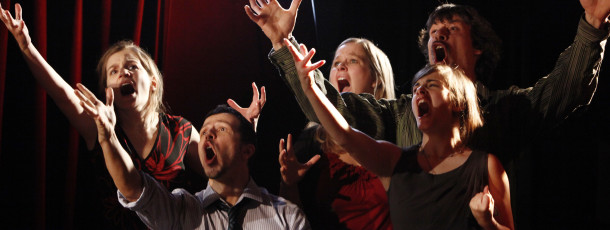5 Improv Techniques to help you improve your acting
Let Go of Your Inhibitions
Audiences respond to one of two triggers: The Unexpected and The Common Experience. Both of these triggers are best expressed when your guard is let down.
Here’s what I mean.
Admitting to the fact that you pick your nose on the way to work is going to get a laugh. Some will be laughing at you because they didn’t expect it (and they pick their noses in the privacy of their own bathroom) and others will laugh with you because they do the same thing but were keeping it quiet.
Everyday, people are playing to social norms and expectations. You stand out when you let go of those inhibitions and explore your creative freedom. Vulnerability and spontaneity can inform this freedom and help set you apart from the rest.
Value Emotional Integrity Over Audience Response
Sometimes, when I’m on stage, the audience is quiet. Painfully quiet. The material falls flat and I wish I could rewind and do something different. The other night I tried to be Michael Jackson, and it was a total dud. My husband later told me that I used a southern accent for that scene.
I went for the joke instead of maintaining the emotional integrity of the Michael Jackson character. In other words, I gave attributes to a character that didn’t fit – and therefore, the audience didn’t connect.
Savvy audiences will see through you in a heartbeat if you try to be something or someone that you’re not.
Saying “Yes, And…”
There’s an improv exercise called “Yes, And.” The first player makes a statement and the second player begin their response with the words, “Yes, And.” For example:
Player A: “I got you a Slip and Slide for your 35th birthday!”
Now, this suggestion feels a bit awkward to the beginning improviser. So it would be tempting to pretend it’s a joke or otherwise deny the situation. But this exercise teaches improvisers to accept the statements made by their fellow players and respond with gems such as:
Player B: “Yes, and let’s go put string bikinis on our cellulite-infested bodies and go strut our stuff in front of the retirement center.”
Raise your hand if you want to see this scene! I know I do.
“Yes, And…” is all about accepting what others have to offer. Consider what others are offering you and respond accordingly. Don’t discount something quickly because it’s something you’ve never encountered before.
Be Specific
Specificity is improv gold. When doing a scene, if I say I’m at a restaurant, every single audience member could have a different image of where that scene takes place. One person might think fast food while another thinks fine dining.
But if I say “Thanks for meeting me at Pete’s Soda Fountain,” that says a lot. Suddenly, my audience can visualize that I’m sitting at an old-fashioned pharmacy counter from the 1950s.
You may think that specificity comes easy. But does it really? Being specific will absolutely take your acting to the next level.
Play from the Top of Your Intelligence
Being specific doesn’t mean dumbing down your material.
Del Close, the late co-founder of the iO Theater in Chicago, taught his students to play from the top of their intelligence. This meant starting scenes in the “middle” instead of starting every scene off with “Hi, how are you? My name is Jane. What’s your name?”
It also means pushing yourself to find the good material. Improvisers know that they can get a quick laugh from a dirty joke or a curse word. But this is often at the expense of a scene or even an entire show. Good improv holds out for the best material.
